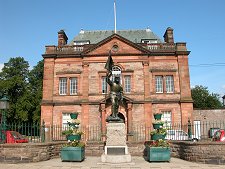Selkirk
| Selkirk | |
| Selkirkshire | |
|---|---|
 Selkirk | |
| Location | |
| Grid reference: | NT471288 |
| Location: | 55°33’-0"N, 2°50’24"W |
| Data | |
| Population: | 5,839 |
| Post town: | Selkirk |
| Postcode: | TD7 |
| Dialling code: | 01750 |
| Local Government | |
| Council: | Scottish Borders |
| Parliamentary constituency: |
Berwickshire, Roxburgh and Selkirk |
The Royal Burgh of Selkirk is the county town of Selkirkshire. It is one of the oldest Royal Burghs in Scotland. It stands on the Ettrick Water, a tributary of the River Tweed.
Selkirk's population grew up because of its woollen industry, although now that that industry has ceased leaving little in its wake, the town is best known for bannocks, a dry fruit cake. It has a museum and art gallery, and associations with Mungo Park, the explorer, James Hogg "The Ettrick Shepherd" a local poet and writer and Walter Scott, a writer of Romances, both of the late eighteenth and early nineteenth century. It is also home to Scotland's oldest horse racing track, the Gala Rig, on the outskirts of the town.
The town's name originates from the Old English Selescirce, meaning Hall Church or Good Church, or as some have it, Church in the Forest.
Selkirk is the site of the first Border Abbey, however the community of Tironensian monks moved to Kelso during the reign of King David I. William Wallace, was declared guardian of Scotland in Selkirk. "Bonnie Prince Charlie", The Marquess of Montrose and the Outlaw Murray all have connections with the town
The people of Selkirk are known as Souters, meaning shoe-maker.
William Wallace
After the death of King Alexander III]], the last heir to the throne of Scotland was Margaret Maid of Norway, who was proclaimed Queen in 1286 at the age of 3 when still in Norway. Margaret, the daughter of King Eric II of Norway and granddaughter of King Alexander III of Scotland, was planned to marry Edward Prince of Wales, so due to inherit the throne of Scotland and in time peacefully to unite it in marriage with England, and possibly with Norway too. She sailed from Norway to assume her throne in 1290, but on Orkney she died at the age of 7. Her death left the Crown of Scotland without a direct heir, but with several claimants. After an arbitration on the succession, King Edward I of England awarded the crown to John Balliol. King John, as had kings before him, paid homage to Edward, but King Edward had been frustrated in his desire for a peaceful union through marriage, and found occasion to declare that the King of Scots had forfeited his crown for disloyalty to his sovereign, and took Scotland into his own hands.
William Wallace, a Scottish knight, led an uprising again the King of England. While there are many places in the Borders associated with Wallace, it was in Selkirk, supported by nobles and clergy, that he was declared "Guardian of the Kingdom of Scotland".
Today in the 'forest kyrk', referred to in ancient times as the church of St Mary of the Forest, visitors can visit this ancient site. (It is also the final resting place to several relatives of Franklin Delano Roosevelt, the 32nd President of the United States of America, whose ancestors came from the area.)
Flodden Field

Many Selkirk men joined King James IV at the Battle of Flodden in 1513. This disastrous campaign, which pitted the King against his own brother-in-law King Henry VIII, ended at Flodden Field in [Northumberland]], the flower of the Scots nobility felled by blade and cannon-shot, the King himself dead within a few yards of his enemy. Only one returned from the battle, "Fletcher", bearing a blood-stained English flag, belonging to the Macclesfield regiment. On his return to Selkirk, so the legend says, he cast the captured English standard around his head to describe that all others had perished in battle.
Selkirk Common Riding
Selkirk commemorates and celebrates her history at the annual Common Riding, always held on the second Friday after the first Monday in June, when the town's boundaries or 'marches' are ridden. Usually in the region of 300-400, Selkirk boasts one of the largest cavalcade of horses and riders in Europe.[1] The culmination of the day involves the town's Standard Bearer casting, or flying, the town's standard (A St Andrew's cross with the town seal placed in the centre) in the Market Square, after which everyone repairs to one of the town's public houses to celebrate.
Battle of Philiphaugh
During the series of conflicts that would become known as the Wars of the Three Kingdoms, Selkirk played host the Royalist army of James Graham, 1st Marquess of Montrose, with his cavalry installed in the burgh, whilst the Royalist infantry were camped at the plain of Philiphaugh, below the town.
On the morning of 13 September 1645, a covenanting army led by Sir David Leslie attacked the royalist forces camped at Philiphaugh, and a rout ensued. Montrose arrived to find his army in disarray and had to the flee the field, eventually leading to his exile.
The action at Philiphaugh is infamous, for the massacre of up to 500 surrendered Royalist troops and camp followers by the covenanters: these included many women and children.
Sir Walter Scott and Selkirk

Sir Walter Scott was appointed Sheriff-Deputy of the County of Selkirk in 1799, and was based in the Royal Burgh's Courthouse, which can be found in the town square.
The Selkirk Grace
The Selkirk Grace, is a grace, a prayer said before a meal, attributed to Robert Burns. Today it is used on occasions such as Burns' Night:
- Some hae meat and canna eat,
- And some wad eat that want it,
- But we hae meat and we can eat,
- Sae let the Lord be thankit.